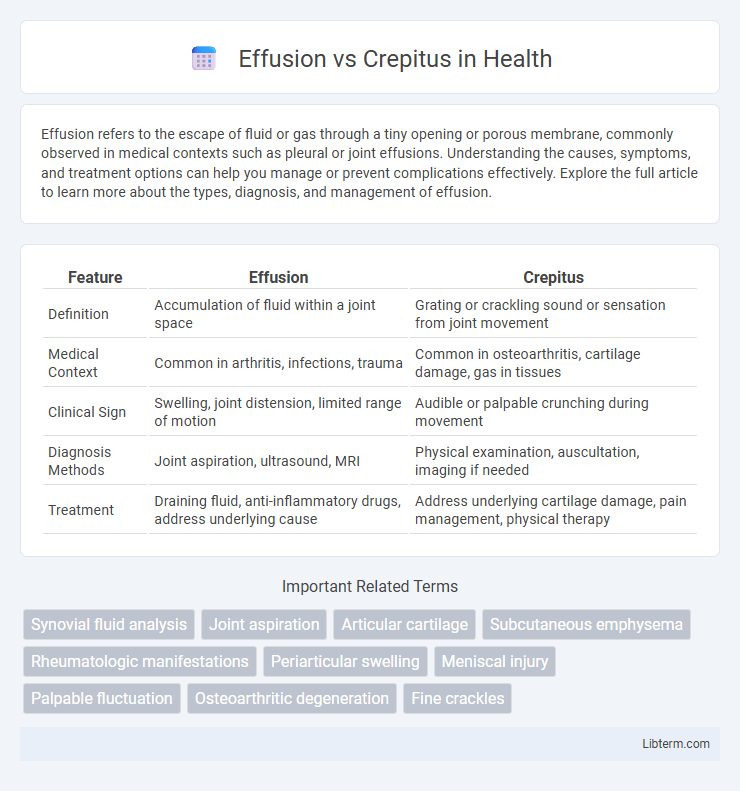Effusion refers to the escape of fluid or gas through a tiny opening or porous membrane, commonly observed in medical contexts such as pleural or joint effusions. Understanding the causes, symptoms, and treatment options can help you manage or prevent complications effectively. Explore the full article to learn more about the types, diagnosis, and management of effusion.
Table of Comparison
| Feature | Effusion | Crepitus |
|---|---|---|
| Definition | Accumulation of fluid within a joint space | Grating or crackling sound or sensation from joint movement |
| Medical Context | Common in arthritis, infections, trauma | Common in osteoarthritis, cartilage damage, gas in tissues |
| Clinical Sign | Swelling, joint distension, limited range of motion | Audible or palpable crunching during movement |
| Diagnosis Methods | Joint aspiration, ultrasound, MRI | Physical examination, auscultation, imaging if needed |
| Treatment | Draining fluid, anti-inflammatory drugs, address underlying cause | Address underlying cartilage damage, pain management, physical therapy |
Introduction to Effusion and Crepitus
Effusion refers to the abnormal accumulation of fluid within a joint space, commonly occurring in conditions such as arthritis or injury, leading to swelling and restricted movement. Crepitus is characterized by a crackling or grating sensation or sound within a joint, often resulting from cartilage wear or the presence of air bubbles in the joint fluid. Both effusion and crepitus are clinical signs used to diagnose underlying joint disorders and guide appropriate treatment strategies.
Defining Effusion: Causes and Symptoms
Effusion refers to the abnormal accumulation of fluid within a joint space, commonly caused by injury, infection, arthritis, or inflammatory conditions. Symptoms of effusion include joint swelling, pain, stiffness, and limited range of motion, often accompanied by warmth and redness over the affected area. Identifying the type and cause of effusion through clinical examination and imaging, such as ultrasound or MRI, is essential for appropriate treatment.
Understanding Crepitus: What It Means
Crepitus refers to the crackling or popping sounds and sensations felt under the skin or joints, often caused by air trapped in soft tissues or the rubbing of irregular joint surfaces. It is commonly associated with conditions such as osteoarthritis, where cartilage deterioration leads to bone-on-bone contact, producing the characteristic noise. Understanding crepitus helps distinguish it from effusion, which involves fluid accumulation in joint spaces, typically causing swelling and limited movement rather than audible sounds.
Key Differences Between Effusion and Crepitus
Effusion refers to the accumulation of excess fluid within a joint space, often caused by inflammation, injury, or infection, whereas crepitus describes a crackling or popping sound or sensation resulting from the rubbing of irregular joint surfaces or gas bubbles in the synovial fluid. Effusion is typically associated with swelling, pain, and restricted movement, while crepitus is commonly observed in conditions like osteoarthritis and can occur during joint motion without significant swelling. The primary diagnostic difference lies in effusion being detectable by physical swelling and imaging techniques such as ultrasound or MRI, whereas crepitus is identified through tactile or auditory examination during joint manipulation.
Common Medical Conditions Involving Effusion
Effusion commonly occurs in medical conditions such as arthritis, where excess fluid accumulates in joints, leading to swelling and pain, and pleural effusion, which involves fluid buildup in the pleural cavity often due to infections like pneumonia or heart failure. Crepitus, characterized by a crackling or popping sensation, is frequently associated with osteoarthritis and joint injuries, resulting from irregular cartilage surfaces or air in soft tissues. Understanding the differences in pathophysiology and clinical presentation helps in diagnosing conditions like rheumatoid arthritis or pneumothorax, where effusion and crepitus may coexist but require distinct treatments.
Disorders Frequently Associated with Crepitus
Crepitus frequently occurs in disorders such as osteoarthritis, rheumatoid arthritis, and temporomandibular joint dysfunction where joint degeneration and inflammation cause audible clicking or grinding during movement. It is also associated with conditions like subcutaneous emphysema and gas gangrene, where trapped gas produces characteristic crackling sounds. Effusion, unlike crepitus, primarily involves fluid accumulation in joints seen in trauma, infection, or inflammatory diseases without producing audible joint noises.
Diagnostic Methods: Effusion vs Crepitus
Effusion is diagnosed primarily through imaging techniques such as ultrasound and MRI, which detect fluid accumulation in joints, while synovial fluid analysis helps confirm inflammatory or infectious causes. Crepitus is evaluated using physical examination, where clinicians assess joint movements for audible or palpable grinding sensations, often complemented by imaging to identify underlying cartilage damage or bone irregularities. Diagnostic differentiation relies on combining clinical assessment with targeted imaging and fluid analysis to identify effusion-related swelling versus crepitus-associated joint surface abnormalities.
Treatment Options for Effusion
Effusion treatment primarily involves addressing the underlying cause, such as infection, inflammation, or injury, with options including aspiration to remove excess fluid, corticosteroid injections to reduce inflammation, and nonsteroidal anti-inflammatory drugs (NSAIDs) to alleviate pain and swelling. Physical therapy is often recommended to restore joint function and prevent stiffness after fluid reduction. In severe or recurrent cases, surgical interventions like arthroscopy may be necessary to repair joint damage or remove persistent effusion.
Management and Relief of Crepitus
Managing crepitus involves addressing the underlying cause, such as joint degeneration or injury, through physical therapy, anti-inflammatory medications, and sometimes corticosteroid injections to reduce inflammation and improve joint function. Techniques like targeted exercises, joint mobilization, and the use of supportive braces can help alleviate symptoms and enhance range of motion. In severe cases, surgical intervention such as arthroscopy or joint replacement may be necessary to provide long-term relief from crepitus-associated discomfort.
Preventive Measures and When to Seek Medical Attention
Effusion preventive measures include maintaining joint hygiene, avoiding repetitive strain, and managing underlying conditions such as arthritis to reduce inflammation and fluid build-up. Crepitus prevention focuses on strengthening muscles around joints, using proper techniques during physical activities, and addressing cartilage wear through early intervention. Seek medical attention if there is persistent swelling, severe pain, restricted movement, or visible joint deformity to prevent complications and ensure accurate diagnosis.
Effusion Infographic

 libterm.com
libterm.com